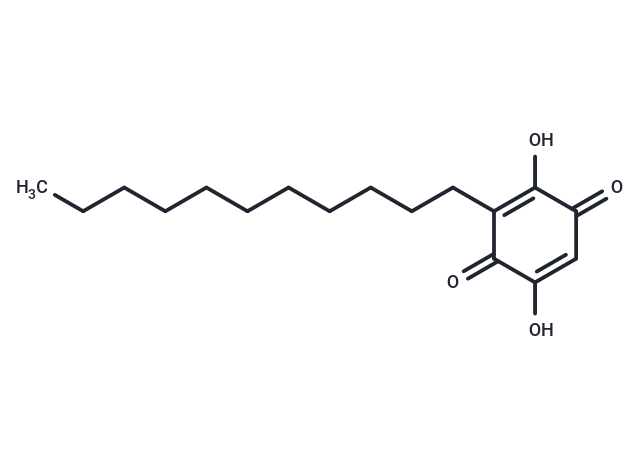Shopping Cart
Remove All Your shopping cart is currently empty
Your shopping cart is currently empty
Embelin (Embelic acid), isolated from the Japanese Ardisia herb, is an inhibitor of the X-linked inhibitor of apoptosis (IC50: 4.1 uM).

| Pack Size | Price | USA Warehouse | Global Warehouse | Quantity |
|---|---|---|---|---|
| 5 mg | $33 | In Stock | In Stock | |
| 10 mg | $48 | In Stock | In Stock | |
| 25 mg | $81 | In Stock | In Stock | |
| 50 mg | $152 | In Stock | In Stock | |
| 100 mg | $255 | In Stock | In Stock | |
| 200 mg | $378 | In Stock | In Stock | |
| 1 mL x 10 mM (in DMSO) | $48 | In Stock | In Stock |
| Description | Embelin (Embelic acid), isolated from the Japanese Ardisia herb, is an inhibitor of the X-linked inhibitor of apoptosis (IC50: 4.1 uM). |
| Targets&IC50 | X linked:4.1 μM |
| In vitro | Embelin from the Japanese Ardisia herb is a small-molecular inhibitor that binds to the XIAP BIR3 domain with which Smac and caspsase-9 bind. Embelin inhibits cell growth of both PC-3 and LNCap cells in a dose-dependent manner, with IC50 values of 3.7 and 5.7 μM. While, the toxicity of Embelin in normal PrEC and in WI-38 cells is much lower with IC50 values of 20.1 μM and 19.3 μM. Treatment of PC-3 cells with 25 and 50 μM of embelin for 48 h, 30% and 75% of cells undergo apoptosis, representing approximately 3-and 9-fold increase as compared to untreated cells. [1] Embelin also potently suppresses the biosynthesis of eicosanoids by selective inhibition of 5-lipoxygenase (5-LO) and Microsomal prostaglandin E2 synthase-1 (mPGES-1) with IC50 = 0.06 and 0.2 mM, respectively. [2] |
| Kinase Assay | Fluorescence Polarization Competitive Binding Assay: Fluorescence polarization experiments are performed in Dynex 96-well, black, round-bottom plates. A 5 μL sample of Embelin dilutions in DMSO, and preincubated XIAP BIR3 protein (0.06 μM) and the N terminus of a Smac peptide (SM7F) (0.01 μM) in the assay buffer are added to 96-well plates to produce a final volume of 125 μL. For each assay, the bound peptide control containing XIAP BIR3 protein and SM7F (equivalent to 0% inhibition) and free peptide control containing only free SM7F (equivalent to 100% inhibition) were included. The plates were mixed and incubated at room temperature for 3 h to reach equilibrium. |
| Cell Research | Cell growth is determined by the MTT-based assay using Cell Proliferation Reagent WST-1 according to the manufacturer's instruction. Cells (5000 cells/well) are grown in medium with 10% FBS, and various concentrations of Embelin are added to the cells. Four to five days later, WST-1 is added to each well and incubated for 1-3 h at 37 °C. Absorbance is measured with a plate reader at 450 nm with correction at 650 nm.(Only for Reference) |
| Synonyms | NSC 91874, Emberine, Embelic acid |
| Molecular Weight | 294.39 |
| Formula | C17H26O4 |
| Cas No. | 550-24-3 |
| Smiles | CCCCCCCCCCCC1=C(O)C(=O)C=C(O)C1=O |
| Relative Density. | 1.131 g/cm3 |
| Storage | keep away from direct sunlight | Powder: -20°C for 3 years | In solvent: -80°C for 1 year | Shipping with blue ice/Shipping at ambient temperature. | ||||||||||||||||||||||||||||||||||||||||
| Solubility Information | Ethanol: 2.9 mg/mL (9.85 mM), Heating is recommended. DMSO: 257.5 mg/mL (874.69 mM), Sonication is recommended. | ||||||||||||||||||||||||||||||||||||||||
| In Vivo Formulation | 10% DMSO+90% Corn Oil: 2 mg/mL (6.79 mM), Sonication is recommeded. Please add the solvents sequentially, clarifying the solution as much as possible before adding the next one. Dissolve by heating and/or sonication if necessary. Working solution is recommended to be prepared and used immediately. The formulation provided above is for reference purposes only. In vivo formulations may vary and should be modified based on specific experimental conditions. | ||||||||||||||||||||||||||||||||||||||||
Solution Preparation Table | |||||||||||||||||||||||||||||||||||||||||
Ethanol/DMSO
DMSO
| |||||||||||||||||||||||||||||||||||||||||
| Size | Quantity | Unit Price | Amount | Operation |
|---|

Copyright © 2015-2025 TargetMol Chemicals Inc. All Rights Reserved.